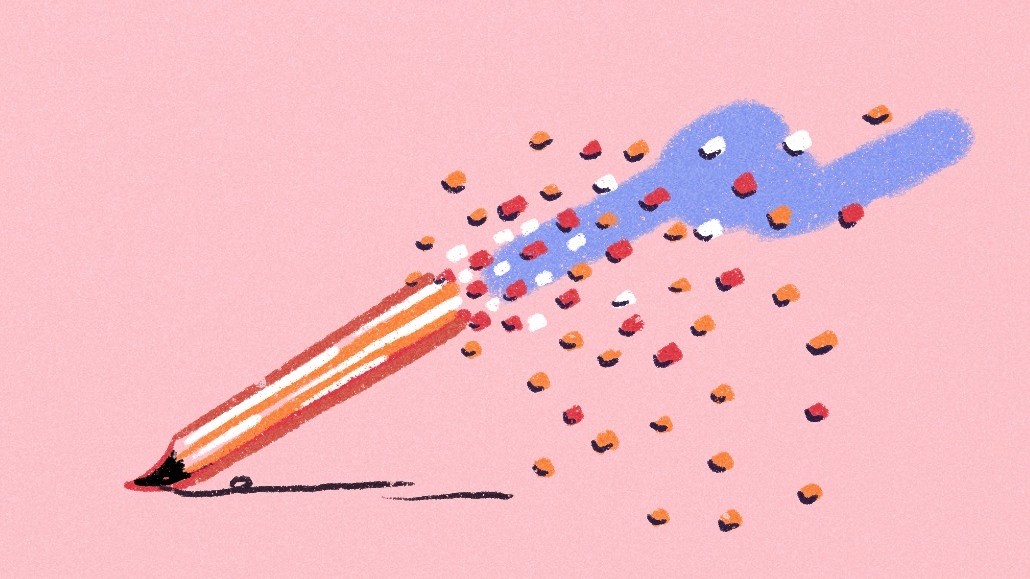Save 50% on a 3-month Digiday+ membership. Ends Dec 5.
Canva’s in-house agency will ‘experiment’ with what it says about the AI used in its advertising

Canva has been developing AI technologies and integrations since 2019, rolling out its own tools for its marketing and creative organization users as well as integrating technology from Google and OpenAI.
Even so, as the Australian design platform, founded in 2013, continues to build AI tools, it’s still figuring out how much its marketing efforts should call attention to its AI.
Canva went live with multiple AI products for the brand design space earlier this year. It has been highlighting those tools in campaigns, including tools like Magic Resize and Magic Replace, which allow users to easily resize something or add something into an image, said Natalie Schwartz, head of global brand and creative at Canva.
“We’ve been typically referring to them like magic,” Schwartz said of how Canva has described its AI tools in its marketing efforts. “We’ll experiment with how much we call out AI versus just demonstrating the benefit to the end user.”
By focusing on what the tool can do rather than that the tool uses AI, Canva aims to have broad appeal beyond consumers who are invested in the current AI hype cycle. Canva also wants to broaden its appeal beyond personal use or use for small businesses and appeal to major marketing organizations.
“For some people, there may still be a hurdle of, ‘Oh if this product has AI or is powered by AI, that’s inaccessible to me’ or ‘That’s something out of my reach,’” said Schwartz. “To date, we’ve focused on how we can show the core benefit. What do you need to do with your design and how can we make that happen for you rather than this is the how or this is the behind-the-scenes [tech].”
Canva’s in-house team, which has over 100 brand designers, videographers, photographers, motion designers and copywriters, are managing the balance of calling out AI in marketing. For work geared toward marketers, that may be more than that of work for other audiences. This week, Canva released data from its new survey of over 4,000 marketing and creatives on how they are feeling about generative AI which found that 75% of marketing and creative leaders already see AI as an “essential part of their toolkit.”
“Now that AI is so much in the conversation and with our recent report we saw that so many marketers are bullish on AI, we will explore talking about it more explicitly,” said Schwartz. “It depends on the audience how much we’ll call out what technology is powering our services.”
That said, the survey also found that 69% feel there are too many AI tools, 65% feel “overwhelmed by the learning curve” and data privacy concerns around “customer data (76%), company data (75%), and personal data (74%)” persist.
Navigating the anxieties of potential customers when it comes to the use of AI can be tricky. “If it’s seen as AI, it might raise anxiety,” said brand consultant and co-founder of Metaforce Allen Adamson. He added that messages focused on making it “easier, faster and better” can appeal to consumers without adding anxiety.
With the latest marketing effort, Canva has focused on digital advertising and removed linear TV from the mix. It’s unclear how much the platform is spending; Canva declined to share specific ad spending data. Throughout the first six months of 2023 the platform spent $27.5 million on advertising, per data from Vivvix, including paid social data from Pathmatics, which also found that Canva spent $100 million on advertising in 2022.
The platform is also focused on growing its in-house team internationally as it looks to build more hub offices across the world and invest in marketing in different countries, explained Schwartz. While the in-house team handles the day-to-day advertising, email marketing, performance marketing and big brand campaigns, the platform has worked with experiential agencies and works with OMD on its media buying.
Canva — which has worked with the likes of Reddit and Sony Music brands, per its website — is focused on showcasing that its products can be used “to increase efficiency, creativity and productivity in the workplace,” Schwartz said.
More in Marketing

Behind the rise of the chief productivity officer and what it means for companies and employees
The CPO is envisioned as the leader who orchestrates people and technology together to drive business outcomes.

OpenX redraws the SSP-agency relationship
The gradual realignment of programmatic’s middlemen discussed at Digiday’s Programmatic Marketing Summit.

Omnicom’s reshuffled leadership emerges as the ad industry’s new power players
Omnicom’s Black Monday saw thousands of jobs cut, and a chosen few put in charge of what is now the world’s largest marketing services group. They face a number of challenges, however.






